Hasan Ferit Eniser
Automatically Testing Functional Properties of Code Translation Models
Sep 07, 2023Abstract:Large language models are becoming increasingly practical for translating code across programming languages, a process known as $transpiling$. Even though automated transpilation significantly boosts developer productivity, a key concern is whether the generated code is correct. Existing work initially used manually crafted test suites to test the translations of a small corpus of programs; these test suites were later automated. In contrast, we devise the first approach for automated, functional, property-based testing of code translation models. Our general, user-provided specifications about the transpiled code capture a range of properties, from purely syntactic to purely semantic ones. As shown by our experiments, this approach is very effective in detecting property violations in popular code translation models, and therefore, in evaluating model quality with respect to given properties. We also go a step further and explore the usage scenario where a user simply aims to obtain a correct translation of some code with respect to certain properties without necessarily being concerned about the overall quality of the model. To this purpose, we develop the first property-guided search procedure for code translation models, where a model is repeatedly queried with slightly different parameters to produce alternative and potentially more correct translations. Our results show that this search procedure helps to obtain significantly better code translations.
Synthesizing a Progression of Subtasks for Block-Based Visual Programming Tasks
May 27, 2023
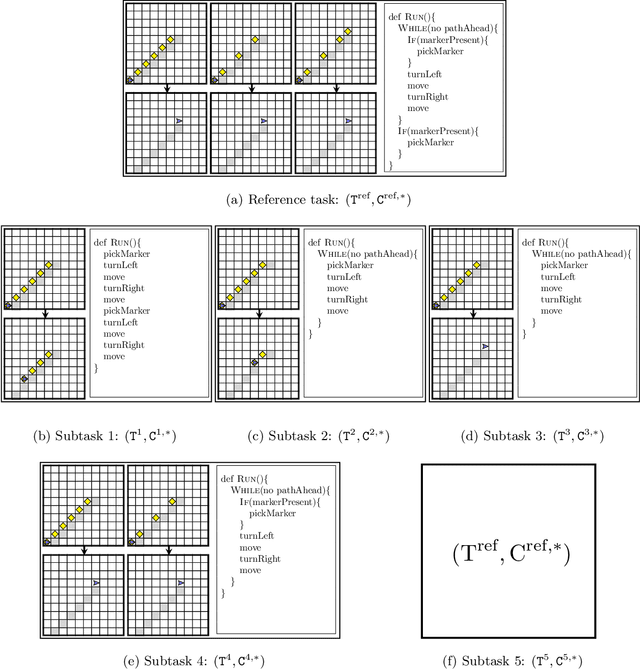
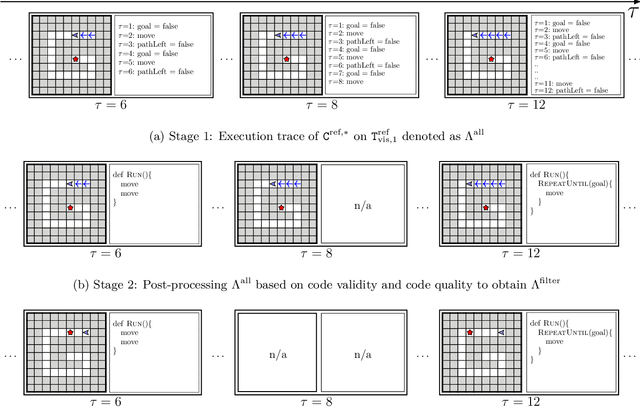

Abstract:Block-based visual programming environments play an increasingly important role in introducing computing concepts to K-12 students. In recent years, they have also gained popularity in neuro-symbolic AI, serving as a benchmark to evaluate general problem-solving and logical reasoning skills. The open-ended and conceptual nature of these visual programming tasks make them challenging, both for state-of-the-art AI agents as well as for novice programmers. A natural approach to providing assistance for problem-solving is breaking down a complex task into a progression of simpler subtasks; however, this is not trivial given that the solution codes are typically nested and have non-linear execution behavior. In this paper, we formalize the problem of synthesizing such a progression for a given reference block-based visual programming task. We propose a novel synthesis algorithm that generates a progression of subtasks that are high-quality, well-spaced in terms of their complexity, and solving this progression leads to solving the reference task. We show the utility of our synthesis algorithm in improving the efficacy of AI agents (in this case, neural program synthesizers) for solving tasks in the Karel programming environment. Then, we conduct a user study to demonstrate that our synthesized progression of subtasks can assist a novice programmer in solving tasks in the Hour of Code: Maze Challenge by Code-dot-org.
Specifying and Testing $k$-Safety Properties for Machine-Learning Models
Jun 13, 2022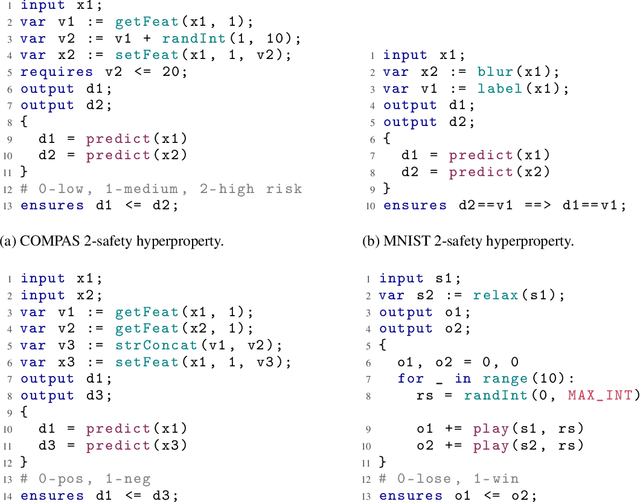
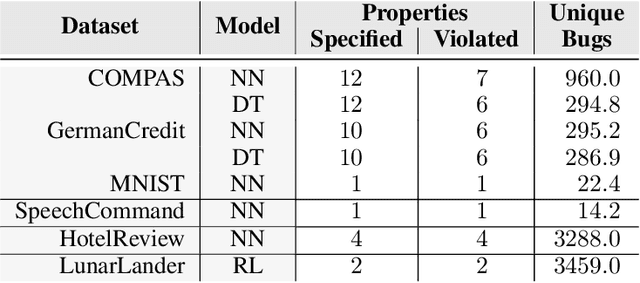
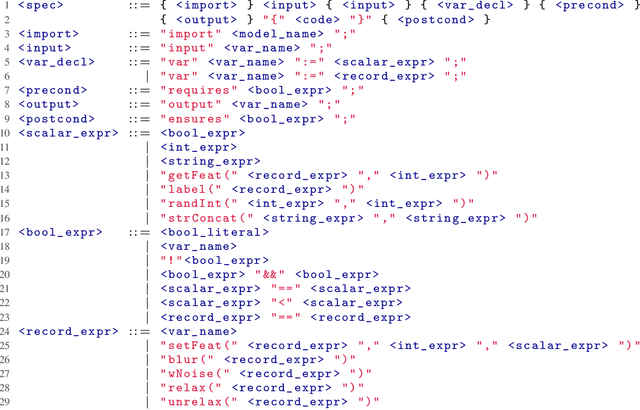
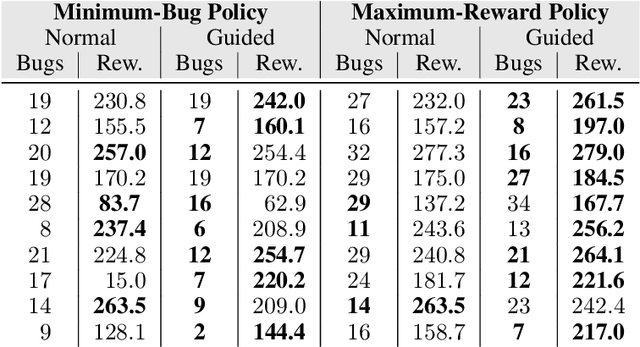
Abstract:Machine-learning models are becoming increasingly prevalent in our lives, for instance assisting in image-classification or decision-making tasks. Consequently, the reliability of these models is of critical importance and has resulted in the development of numerous approaches for validating and verifying their robustness and fairness. However, beyond such specific properties, it is challenging to specify, let alone check, general functional-correctness expectations from models. In this paper, we take inspiration from specifications used in formal methods, expressing functional-correctness properties by reasoning about $k$ different executions, so-called $k$-safety properties. Considering a credit-screening model of a bank, the expected property that "if a person is denied a loan and their income decreases, they should still be denied the loan" is a 2-safety property. Here, we show the wide applicability of $k$-safety properties for machine-learning models and present the first specification language for expressing them. We also operationalize the language in a framework for automatically validating such properties using metamorphic testing. Our experiments show that our framework is effective in identifying property violations, and that detected bugs could be used to train better models.
Importance-Driven Deep Learning System Testing
Feb 09, 2020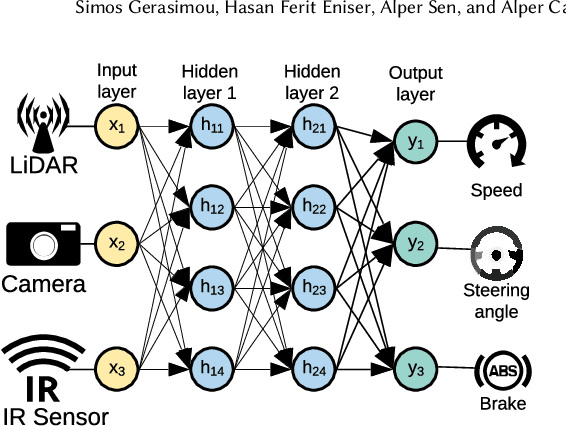
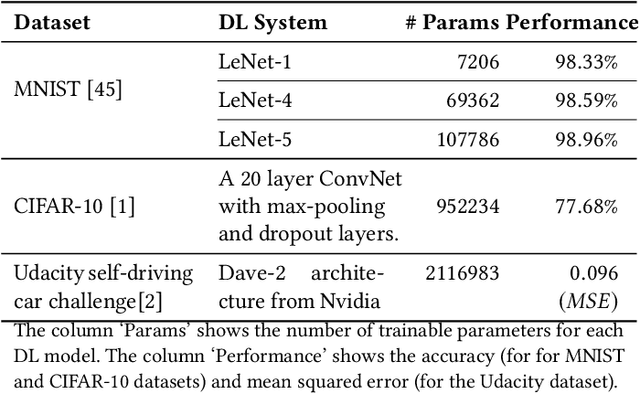

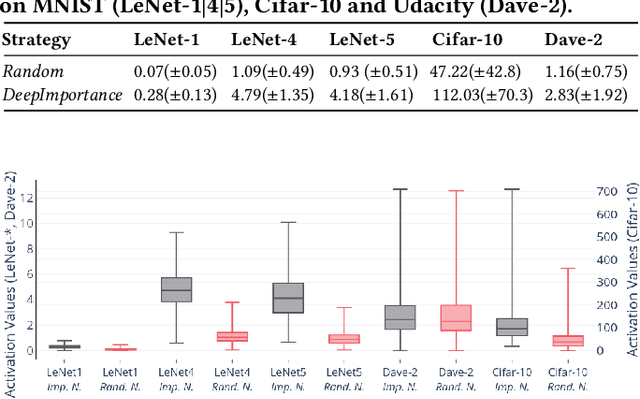
Abstract:Deep Learning (DL) systems are key enablers for engineering intelligent applications due to their ability to solve complex tasks such as image recognition and machine translation. Nevertheless, using DL systems in safety- and security-critical applications requires to provide testing evidence for their dependable operation. Recent research in this direction focuses on adapting testing criteria from traditional software engineering as a means of increasing confidence for their correct behaviour. However, they are inadequate in capturing the intrinsic properties exhibited by these systems. We bridge this gap by introducing DeepImportance, a systematic testing methodology accompanied by an Importance-Driven (IDC) test adequacy criterion for DL systems. Applying IDC enables to establish a layer-wise functional understanding of the importance of DL system components and use this information to assess the semantic diversity of a test set. Our empirical evaluation on several DL systems, across multiple DL datasets and with state-of-the-art adversarial generation techniques demonstrates the usefulness and effectiveness of DeepImportance and its ability to support the engineering of more robust DL systems.
RAID: Randomized Adversarial-Input Detection for Neural Networks
Feb 07, 2020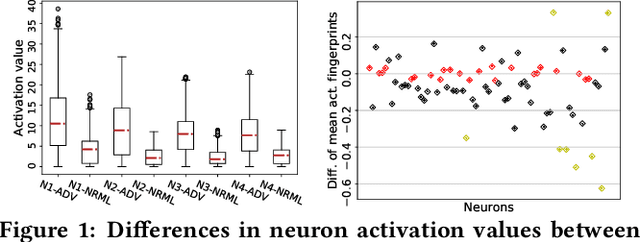
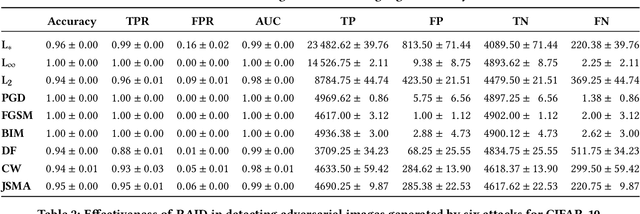
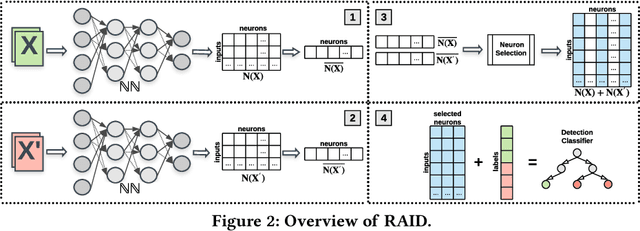
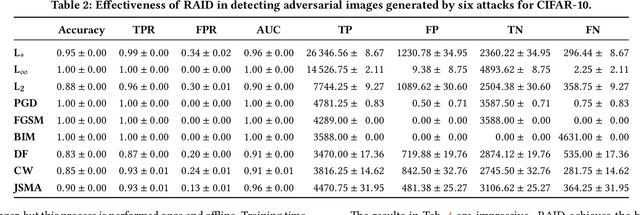
Abstract:In recent years, neural networks have become the default choice for image classification and many other learning tasks, even though they are vulnerable to so-called adversarial attacks. To increase their robustness against these attacks, there have emerged numerous detection mechanisms that aim to automatically determine if an input is adversarial. However, state-of-the-art detection mechanisms either rely on being tuned for each type of attack, or they do not generalize across different attack types. To alleviate these issues, we propose a novel technique for adversarial-image detection, RAID, that trains a secondary classifier to identify differences in neuron activation values between benign and adversarial inputs. Our technique is both more reliable and more effective than the state of the art when evaluated against six popular attacks. Moreover, a straightforward extension of RAID increases its robustness against detection-aware adversaries without affecting its effectiveness.
DeepSmartFuzzer: Reward Guided Test Generation For Deep Learning
Nov 24, 2019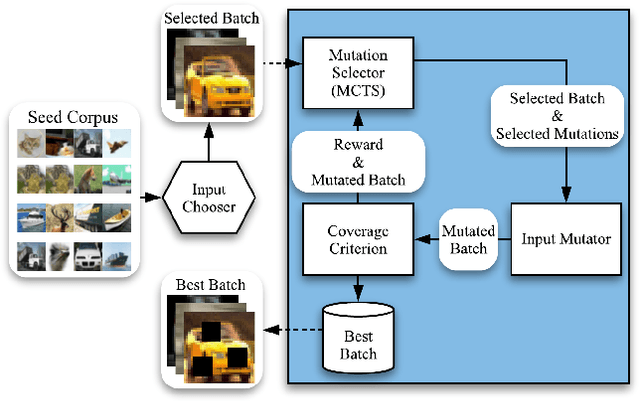
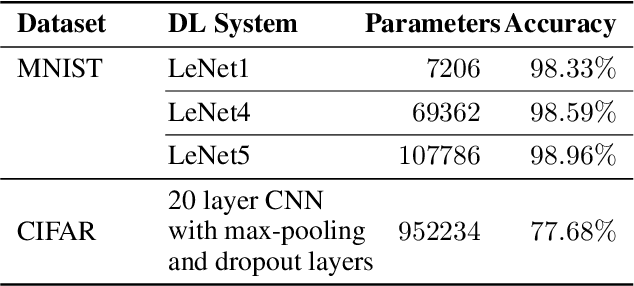
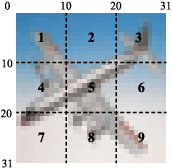

Abstract:Testing Deep Neural Network (DNN) models has become more important than ever with the increasing usage of DNN models in safety-critical domains such as autonomous cars. The traditional approach of testing DNNs is to create a test set, which is a random subset of the dataset about the problem of interest. This kind of approach is not enough for testing most of the real-world scenarios since these traditional test sets do not include corner cases, while a corner case input is generally considered to introduce erroneous behaviors. Recent works on adversarial input generation, data augmentation, and coverage-guided fuzzing (CGF) have provided new ways to extend traditional test sets. Among those, CGF aims to produce new test inputs by fuzzing existing ones to achieve high coverage on a test adequacy criterion (i.e. coverage criterion). Given that the subject test adequacy criterion is a well-established one, CGF can potentially find error inducing inputs for different underlying reasons. In this paper, we propose a novel CGF solution for structural testing of DNNs. The proposed fuzzer employs Monte Carlo Tree Search to drive the coverage-guided search in the pursuit of achieving high coverage. Our evaluation shows that the inputs generated by our method result in higher coverage than the inputs produced by the previously introduced coverage-guided fuzzing techniques.
DeepFault: Fault Localization for Deep Neural Networks
Feb 15, 2019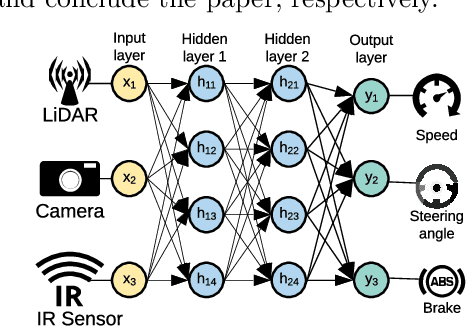
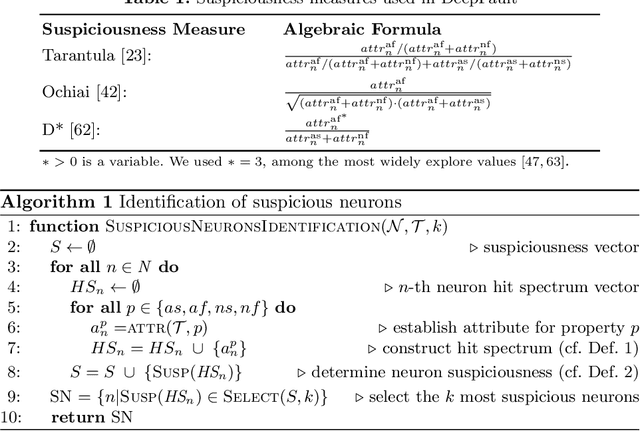


Abstract:Deep Neural Networks (DNNs) are increasingly deployed in safety-critical applications including autonomous vehicles and medical diagnostics. To reduce the residual risk for unexpected DNN behaviour and provide evidence for their trustworthy operation, DNNs should be thoroughly tested. The DeepFault whitebox DNN testing approach presented in our paper addresses this challenge by employing suspiciousness measures inspired by fault localization to establish the hit spectrum of neurons and identify suspicious neurons whose weights have not been calibrated correctly and thus are considered responsible for inadequate DNN performance. DeepFault also uses a suspiciousness-guided algorithm to synthesize new inputs, from correctly classified inputs, that increase the activation values of suspicious neurons. Our empirical evaluation on several DNN instances trained on MNIST and CIFAR-10 datasets shows that DeepFault is effective in identifying suspicious neurons. Also, the inputs synthesized by DeepFault closely resemble the original inputs, exercise the identified suspicious neurons and are highly adversarial.
 Add to Chrome
Add to Chrome Add to Firefox
Add to Firefox Add to Edge
Add to Edge